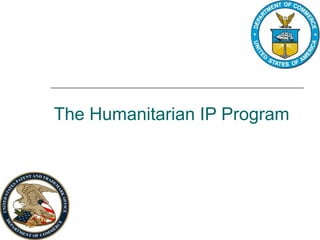
Case For Humanitarian IP Program
- 1. The Humanitarian IP Program
- 2. OVERVIEW The United States Patent & Trademark Office (USPTO) has developed a voluntary, pro-business pilot program to incentivize the development and distribution of technology that addresses humanitarian needs.
- 3. BACKGROUND Greatest need of humanitarian support coincides with breakdowns in the market or government structure, specifically: Impoverished populations with insufficient capital to provide the needed ROI Areas lacking appropriate infrastructure Countries lacking adequate protection for inventions
- 4. WHY THE USPTO? USPTO is uniquely positioned to help address these problems Respected leading voice on IP matters Working relationship with the authors of technological progress History of cooperation with industry Leverage contacts to develop win-win solutions Highlight the benefits IP has for developing regions
- 5. PROPOSAL Incentivize and reward patent owners who make meaningful contributions to humanitarian needs. Provide a transferrable voucher for expedited processing at the USPTO. Recipients may apply the voucher to one of their own patents or sell it on the open market.
- 6. EXTERNAL SUPPORT USPTO issued a public Request For Comments in Sept 2010. Respondents from industry, academia, and NGOs were very supportive of the program. USPTO continues to solicit feedback from stakeholders to address concerns and ensure success. "BIO commends the USPTO for likewise exploring creative and market-oriented ways to incentivize the development and distribution of humanitarian technologies, a goal that BIO and its members have long shared and are working hard to achieve." -James Greenwood BIO’s President & CEO
- 7. EXTERNAL SUPPORT “I enthusiastically support the exploration and intent behind the ‘Humanitarian IP program’, as I view it as a critical component in a system for accelerating the delivery of inclusive (pro-poor) innovations (in health and agriculture to developing countries).” -Stanley Kowalski Professor of Law and Director of The International Technology Transfer Institute University of New Hampshire
- 8. DEFINITIONS Humanitarian issue – one significantly affecting the public health or quality of life of an impoverished population Qualifying criteria (roughly): Actions that significantly increase usage of the technology by an impoverished group to address a humanitarian issue Actions that make the technology available to others for research on a humanitarian issue
- 9. APPROACH Focus on actually delivering life-altering treatments/products/services to suffering people in need Triple Neutral Approach: Technology – open to all fields Geography – help impoverished people anywhere Finance – focus on results achieved, not $$ accommodates all business models
- 10. ELIGIBLE TECHNOLOGIES Any technology used for humanitarian purposes may qualify, such as: Health/Life Sciences (e.g. medicines, medical devices) Chemical (e.g. water purification) Mechanical (e.g. mine detector) Agriculture (e.g. enhanced crops) Energy (e.g. hazardous waste treatment) IT (Hardware and Software) (e.g. malaria zapper) And others…
- 11. PROCESS Participants will submit prize applications describing how they have made significant contributions to humanitarian goals with their patented technology according to the program criteria Expert judges will evaluate the applications
- 12. JUDGING MECHANISM 2-Round Review Process Evaluation by outside experts with backgrounds in technology and humanitarian aid Finalselections performed by the Patent Public Advisory Committee
- 13. TIMELINE FRN to be published May 2011 Pilot rollout in 2nd half of FY 2011
- 14. PERCEIVED BENEFITS FROM IMPACT INVESTING INCENTIVIZATION Average Return Expectations by instrument and region “Impact Investments: An Emerging Asset Class.” J.P.Morgan, Global Research. 29 Nov 2010
- 15. SUMMARY USPTO program to reward humanitarian use of intellectual property Opportunity to advance U.S. and world interests in humanitarian aid USPTO uniquely positioned to lead Leverages existing forces in industry and academia to greater effect
- 16. CONCLUSION In our global economy, progress in even the poorest countries can advance the prosperity and security of people far beyond their borders, including my fellow Americans. -President Barack Obama, September 22, 2010 U.N. Millenium Development Goals Summit